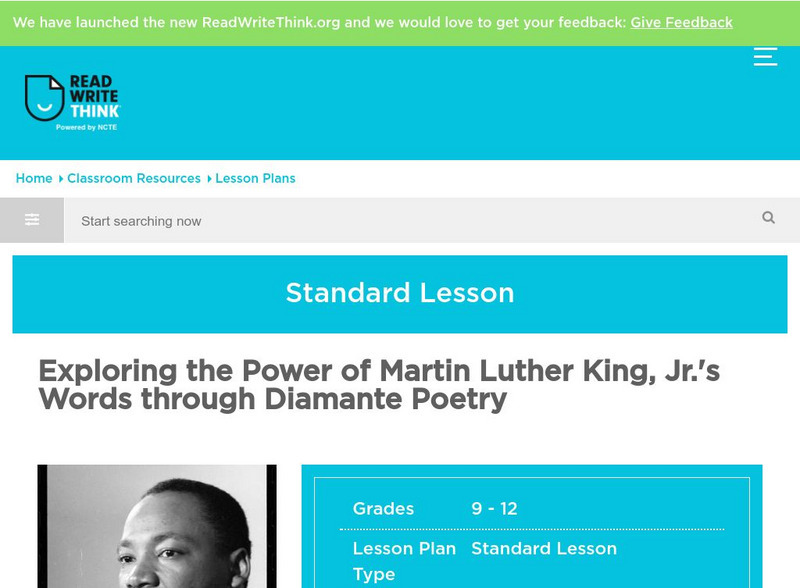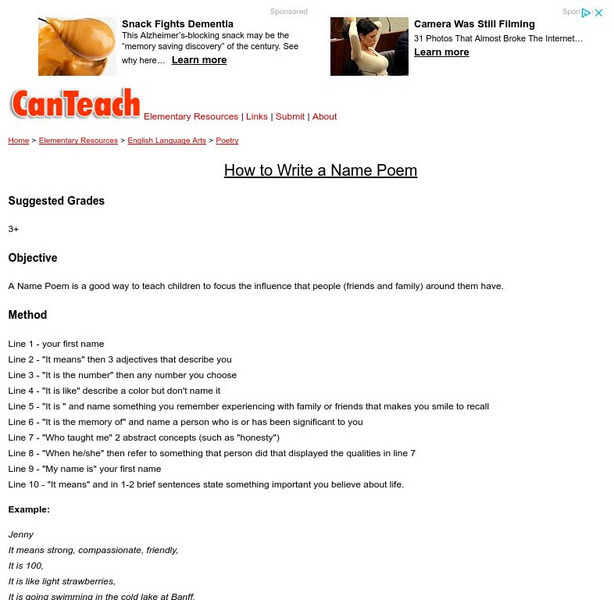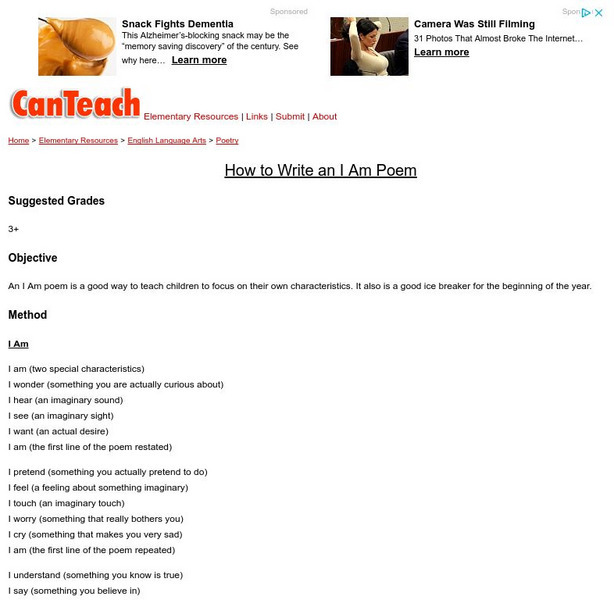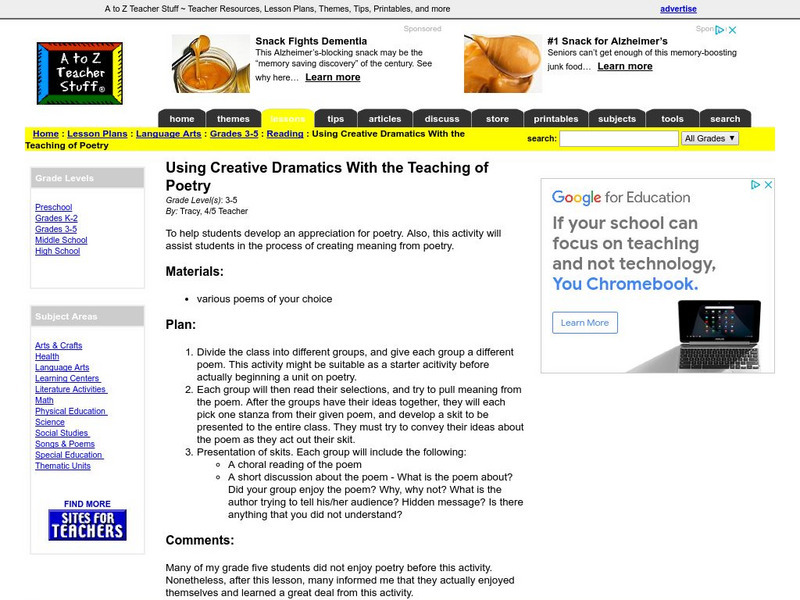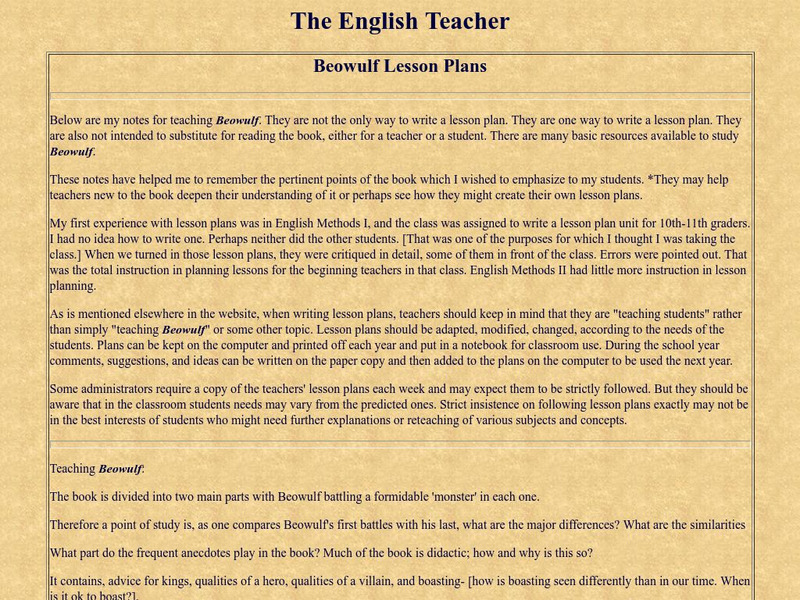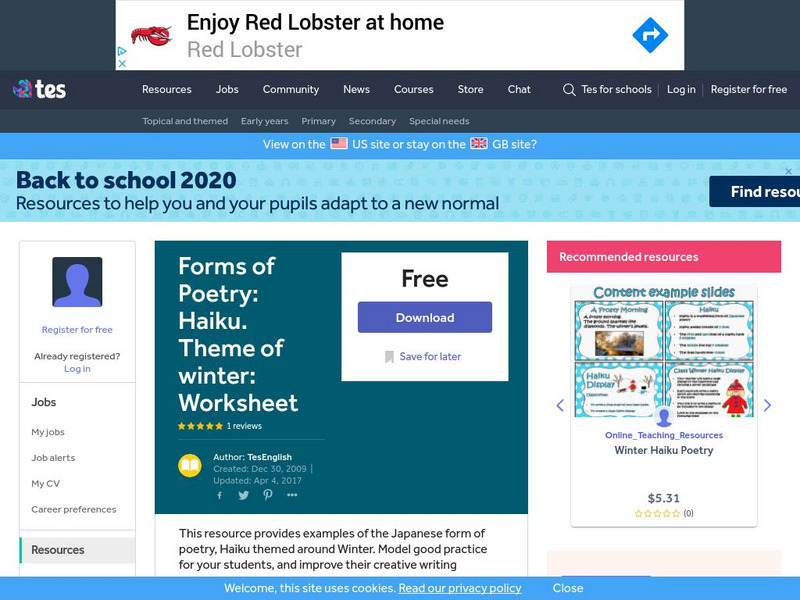Hi, what do you want to do?
ReadWriteThink
Read Write Think: Exploring Mlk's Words Through Poetry
This online lesson attempts to teach students the power of Martin Luther King's words in his "I Have a Dream" speech and others. Students create a diamante poem (seven-line diamond-shaped poem) to analyze and evaluate his words and...
ReadWriteThink
Read Write Think: Poetic Form and Structure
This online lesson makes use of concrete poems to teach the structure and form of poetry. Uses a "Columbus Day," theme for the lesson, but can be used any time of the year.
CommonLit
Common Lit: Units: Teaching Units
Complete teaching units (12) by grade level. CommonLit units are crafted to be both engaging and rigorous, featuring a variety of literary and informational texts from diverse sources. Reading, writing, and discussion are prioritized in...
Can Teach
Can Teach: How to Write a Name Poem
This site describes how a Name Poem is a good way to teach children to focus the influence that people (friends and family) around them have. Lesson plan indicated for 3rd grade and above.
Can Teach
Can Teach: How to Write a Diamond Poem
This is a good poem format to help teach adjectives, verbs, and nouns. Lesson plan indicated for 2nd grade and above.
Can Teach
Can Teach: How to Write an "I Am" Poem
This is a template for "I Am" poetry. Students will focus on their own characteristics as they create an autobiographical poem.
Can Teach
Can Teach: How to Write a Cinquain
At the most basic level a cinquain is a five line poem or stanza. Here are two variations. Lesson plan indicated for 1st grade and above.
A to Z Teacher Stuff
Ato Zteacherstuff: Dramatics With the Teaching of Poetry
This site from atozteacherstuff.com provides a lesson to help young scholars develop an appreciation for poetry. This site will also will help create meaning from poetry.
TES Global
Tes: Prose. Toad Rage
[Free Registration/Login Required] This resource features related activities connected to Morris Geitzman's book, Toad Rage. Students will read a fable, nonfiction reading, prose reading, and connected writing activities.
ReadWriteThink
Read Write Think: Seasonal Haiku
This site is a three-part lesson that teaches students how to write and depict seasonal imagery through haiku. Students study, listen to, and create original haiku on colored backgrounds.
Scholastic
Scholastic Instructor: Teaching With Pourquoi Tales
This site features activities that revolve around "Teaching With Pourquoi Tales." Students will learn more about these types of old legends that deal with the natural world.
Better Lesson
Better Lesson: Revising Our Argument for Presentation Part 1
Learners will compare and contrast the written form of Sojourner Truth's "Ain't I a Woman" to a live reading of the poem by an actress. Follow-up activities provided.
The English Teacher
The English Teacher: Beowulf Lesson Plans
These teaching notes for Beowulf provide a model for your own lesson plan and as a basic resource to study Beowulf. These notes can help you remember the pertinent points of Anglo-Saxon epic poem and help to deepen your understanding.
TES Global
Tes: Forms of Poetry: Haiku. Theme of Winter: Worksheet
[Free Registration/Login Required] Students will learn about the form of a haiku. Students will read several examples of haikus and then write their own haikus about the topic of Christmas or New Year's Eve.
Writing Fix
Writing Fix: Moving West
In this cross curricular lesson plan students will learn how to write a concept poem regarding an immigrant trail. Covered Wagons, Bumpy Trails by Verla Kay is a helpful tool, but not necessary to teach the lesson plan.
ReadWriteThink
Read Write Think: Responding to Gwendolyn Brooks' "We Real Cool"
Contains plans for five lessons based off Gwendolyn Brooks? ?We Real Cool? where young scholars imagine they are the characters in the poem fifty years later. In addition to objectives and standards, this instructional plan contains...
ReadWriteThink
Read Write Think: Onomatopoeia: A Figurative Language Mini Lesson
Contains plans for a minilesson that teaches about onomatopoeia using Edgar Allan Poe's poem "The Bells." In addition to objectives and standards, this instructional plan contains links to sites used in the lesson as well as assessment...
ReadWriteThink
Read Write Think: Family Ties Making Connections to Improve Reading Comprehension
Contains plans for five lessons that teach students to make authentic connections to reading selections. Lessons use books such as "Bigmama?s" by Donald Crews, "The Snowy Day" by Ezra Jack Keats, and "The Relatives Came" by Cynthia...
New Zealand Ministry of Education
Nz Ministry of Education: The Bell Jar
This lesson discusses Sylvia Plath's works including The Bell Jar. It has students look at biographic information and commentaries about Plath. As students read the novel, they complete response logs and write essays. They debate topics...
ReadWriteThink
Read Write Think: Teaching Personification Through Poetry
This lesson plan examines the use of personification in the "great poets." Included in the lesson plan is an overview, practice, objectives, resources, preparation, and more.
Varsity Tutors
Varsity Tutors: Web English Teacher
Teaching resources, lesson plans, study guides, and other resources cataloged for easy access by language arts teachers. The majority of resources deal with reading and literature, although there are also sections on grammar, writing,...
Varsity Tutors
Varsity Tutors: Web English Teacher
Teaching resources, lesson plans, study guides, and other resources cataloged for easy access by language arts teachers. The majority of resources deal with reading and literature, although there are also sections on grammar, writing,...
ReadWriteThink
Read Write Think: Writing About Writing: An Extended Metaphor Assignment
Contains plans for five lessons that teach extended metaphors using Richard Wilbur's poem "The Writer." In addition to objectives and standards, this instructional plan contains links to sites used in the lessons as well as assessment...
ReadWriteThink
Read Write Think: Teaching the Epic Through Ghost Stories
This lesson plan uses the oral tradition of ghost stories (anchored in the Gothic) as a means of explaining the oral tradition of the epics. Included in the lesson plan is an overview, practice, objectives, resources, preparation, and more.





